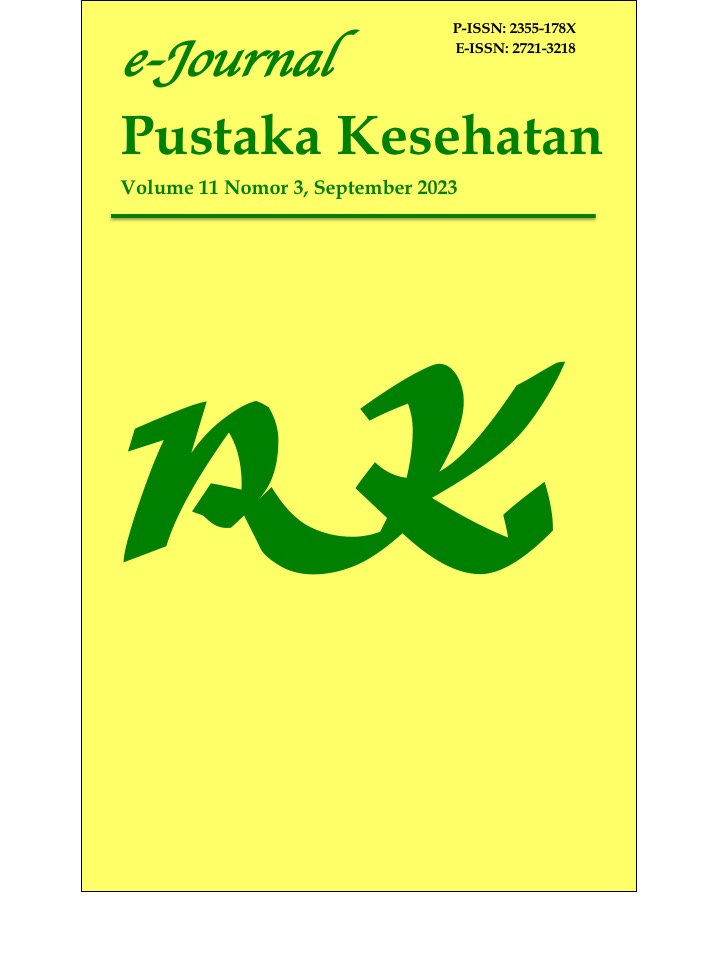Hubungan Efikasi Diri dengan Stres Kerja pada Petani Tembakau di Kecamatan Kalisat-Jember
DOI:
https://doi.org/10.19184/pk.v11i3.11597Keywords:
Self efficacy, occupational stress, tobacco farmerAbstract
The increase in self-efficacy in tobacco farmers has an important role related to occupational stress management. This research aimed to analyze the correlation between self-efficacy with the occupational stress of tobacco farmers in the subdistrict Kalisat Regency Jember. The method of this research was a cross-sectional study with 100 tobacco farmers using a cluster sampling technique. The study was conducted in April in Kalisat District, Jember Regency. Bivariate analysis used Pearson correlation (α <0.1; CI = 90%). The research instrument of self-efficacy used GSE (General Self-Efficacy) with α Cronbach =0.76-0.9 and DASS (Depression Anxiety Stress Scale) with α cronbach=0.88. This research has passed the research feasibility through the Health Research Ethics Commission (KEPK) of the Faculty of Dentistry, University of Jember No. 270/UN 25.8./KEPL/DL. The results showed high self-efficacy (30,31%) and low occupational stress (17,39%). The results of the univariate analysis showed high self-efficacy with an average value of 30,31% (sd= 5,75) and low occupational stress with an average value of 17,39 (sd=5,79). The results of the bivariate analysis showed that there was a significant relationship between self-efficacy and occupational stress with Pearson correlation values ​​p <0,000 (α <0.1; CI = 90%). Behavior showed by the tobacco farmers is that they highly believe themselves to work in tobacco farms. One who has high self-efficacy is able to overcome occupational stress. The results of this study are expected to help to improve occupational health services. This functioned to maintain and improve the health status of tobacco farmers.
Downloads
References
[2] Statistik BP. Kecamatan kalisat dalam angka 2018. 2018; Available from: https://www.bps.go.id/
[3] Susanto, T. dan Purwandari R. Model perawatan kesehatan keselamatan kerja berbasis agricultural nursing. Agric Nurs. 2015;Jember(Program Studi Ilmu Keperawatan Universitas Jember).
[4] Ramesh, A. S. dan MC. Occoputional stress among farming people. journal of agricultural. J Agric. 2009;4(3):115–57.
[5] Stuart GW. Prinsip dan praktik keperawatan kesehatan jiwa. 1st ed. Budi Anna Keliat dan Jesika Pasaribu, editor. Singapura: Elsivier; 2013.
[6] Prestiana, N. D. I. dan Purbandini D. Hubungan antara efikasi diri (self efficacy) dan stres kerja dengan kejenuhan kerja (burnout) pada perawat IGD dan ICU RSUD Kota Bekasi. J soul. 2012;5(2):1–14.
[7] Nadirawati R. Hubungan efikasi diri akademik pada mahasiswa baru Fakultas Keperawatan Universitas Jember. Jember: Program Studi Sarjana Keperawatan Fakultas Keperawatan Universitas Jember; 2018.
[8] Nafi’ah N. Hubungan persepsi beban kerja perawat dengan stres kerja perawat dalam kegiatan mempertahankan akreditasi rumah sakit paripurna di rumah sakit TK.III Baladhika Husada Jember. Jember: Program Sarjana Keperawatan Fakultas Keperawatan Universitas Jember; 2018.
[9] Puspitasari, Y. R., Huda, S. B. M., dan Cahyono K. Beberapa faktor yang berpengaruh terhadap perilaku kerja aman (safety behavior) petani tembakau di Kabupaten Temanggung. J Kesehat. 2019;7(1):2356–3346.
[10] Aji BAD. Hubungan antara self efficacy dengan perilaku penggunaan alat perlindungan diri (apd) pada petani untuk mencegah penyakit akibat pestisida di Desa Ploasan Kecamatan Plaosan Kabupaten Magetan. Malang: Program Studi Ilmu Keperawatan Fakultas Ilmu Kesehatan Universitas Muhammadiyah Malang; 2015.
[11] Indriani MY. Hubungan tingkat stres dengan kejadian hipertensi pada kelompok petani tembakau yang mengalami gagal panen di Kecamatan Pakusari Kabupaten Jember. Jember: Program Studi Sarjana Keperawatan Fakultas Keperawatan Universitas Jember; 2018.
[12] Intani AC. Hubungan beban kerja dengan stres pada petani lansia di kelompok tani tembakau Kecamatan Sukowono Kabupaten Jember. Jember: Program Studi Ilmu Keperawatan Universitas Jember; 2018.
[13] Freidman MM. Buku ajar keperawatan keluarga: Riset.Teori dan Praktik. Jakarta: EGC; 2010.
[14] Rahmawati S. Analisis stes kerja karyawan pada Pt. bank rakyat indonesia (presero) Tbk. cabang Bogor. Jakarta: Fakultas Ekonomi dan Manajemen Unversitas Jakarta; 2016.
[15] Roboth JY. Analisis work family conflik, stres kerja dan kinerja wanita berperan ganda pada yayasan compassion east Indonesia. J Ris bisnis dan Manaj. 2015;3(1):33–46.
[16] Nugroho, A., Yuantari, C. dan HE. Hubungan antara beban kerja dengan tingkat kelelahan pada petani di Desa Curut Kecamatan Penawangan. Semarang: Fakultas Kesehatan Universitas Dian Nuaswantoro; 2013.
[17] Aprianto D., Kristiyawati, P. S., Purnomo SEC. Efektifitas teknik relaksasi imajinasi terbimbing dan nafas dalam terhadap penurunan kecemasan pada pasien pre operasi. Semarang: Program Studi S1 Ilmu Keperawatan STIKES Telogorejo Semarang; 2013.
[18] Magfirah S., Sudiana, I. K., Widywati IY. Relaksasi otot progresif terhadap stres psikologis dan perilaku keperawatan diri pasien diabetes mellitus tipe 2. Kesehat Masy. 2015;10(2):137–46.
[19] Affandi IM. Pengaruh terapi relaksasi napas dalam dan hypnosis lima jari terhadap tingkat stres mahasiswa Program Studi Ilmu Keperawatan Univerisitas ‘Aisyah Yogyakarta. Yogyakarta: Program Studi Ilmu Keperawatan Fakultas Kesehatan Universitas Aisyah; 2017.
[20] Manuntung A. Terapi perilaku kognitif pada pasien hipertensi. Malang: Wineka Media; 2018.
[21] Hasfrentia YD. Hubungan antara self-efficacy dengan stres akademik pada pelajaran SMAN 1 Tuntang. Tuntang: Fakultas Psikologi Universitas Kristen Satya Wacana; 2018.
[22] Farikhah F. Pengaruh self efficacy terhadap stres mahasiswa angakatan 2010 yang menyusun skripsi Fakultas Psikolog UIN Maulana Malik Ibrahim Malang. Malang: Fakultas Psikolog: Universitas Islam Negeri Maulana Malik Ibrahim Malang; 2014.
[23] Peterson, S. J. dan Bredow T. Middle range theories: application to nursing research. In: Nursing research [Internet]. Philadelphia; 2013. Available from: https://cmc.marmot.org/Record/.b38112620 .
Downloads
Published
Issue
Section
License
e-Journal Pustaka Kesehatan has CC-BY-SA or an equivalent license as the optimal license for the publication, distribution, use, and reuse of scholarly work. Authors who publish with this journal retain copyright and grant the journal right of first publication with the work simultaneously licensed under a Creative Commons Attribution-ShareAlike 4.0 International License that allows others to share the work with an acknowledgment of the work's authorship and initial publication in this journal.



